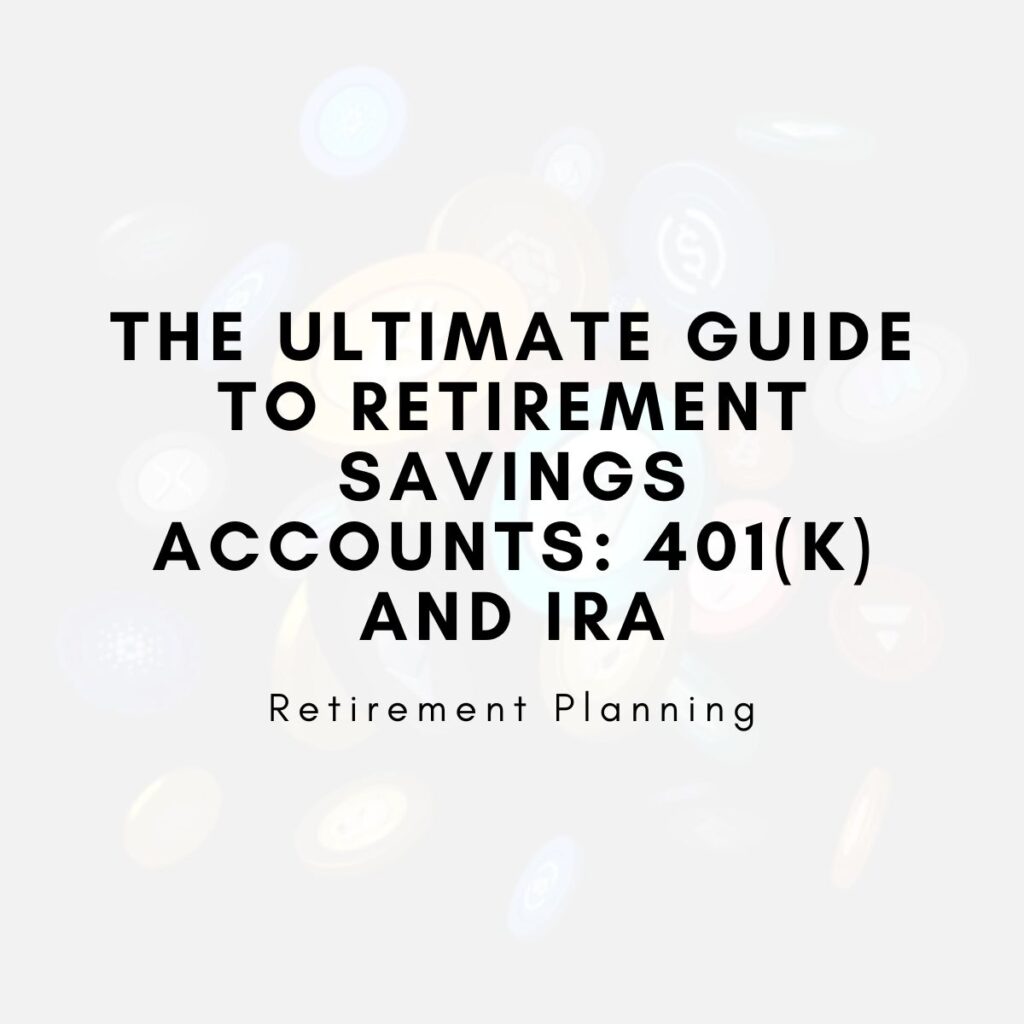
What are the key differences between 401(k) and IRA accounts, and how can you maximize their benefits?
Retirement savings accounts like the 401(k) and IRA play a crucial role in building a secure financial future. This guide explores both options, detailing how they work, their tax advantages, contribution limits, withdrawal rules, and strategies for choosing the right account. Real-life examples illustrate how these accounts can be used to maximize retirement savings.
Summary Table: The Ultimate Guide to Retirement Savings Accounts: 401(k) and IRA
| Section | Summary | Key Tips | Examples |
|---|---|---|---|
| What Is a 401(k) Account? | A retirement savings plan offered by employers with tax-deferred growth and potential employer matching. | – Contribute enough to get the full employer match. – Take advantage of automatic paycheck deductions. | John contributes 10% of his $100,000 salary and gets a $3,000 employer match, increasing his total annual savings to $13,000. |
| What Is an IRA? | Individual retirement accounts with two primary types: Traditional (tax-deferred) and Roth (tax-free withdrawals). | – Choose a Roth IRA for tax-free withdrawals. – Open an IRA if you don’t have a 401(k). | Mike contributes $6,500 annually to a Roth IRA, ensuring tax-free withdrawals in retirement. |
| Key Differences Between 401(k) and IRA | 401(k) accounts have higher contribution limits and employer matching, while IRAs offer more investment flexibility and options for self-employed individuals. | – Maximize your 401(k) if you get an employer match. – Use an IRA to diversify investments. | Sarah, who works for a tech company, uses her 401(k) with a $5,000 employer match and adds $6,500 to her Roth IRA annually. |
| Contribution Limits | 401(k) allows contributions up to $22,500 for those under 50, while IRA contributions are limited to $6,500. | – Maximize both accounts annually to boost retirement savings. | Lisa, aged 55, contributes $30,000 to her 401(k) and $7,500 to her IRA using the catch-up contributions allowed for those over 50. |
| Withdrawal Rules | Early withdrawals before age 59½ incur penalties, except for Roth IRA contributions. RMDs are required at age 73 for 401(k) and Traditional IRA. | – Avoid early withdrawals unless necessary. – Be aware of RMDs for tax planning. | Jack withdrew $10,000 early from his IRA, paying a $1,000 penalty and $2,400 in taxes, reducing his total amount to $6,600. |
| Maximizing Retirement Savings | Increasing contributions over time and diversifying investments across different asset classes can help maximize returns. | – Gradually raise your contribution percentage. – Spread investments across various asset types. | Anna increased her contributions by 2% annually, starting at 5%, and now saves 15% of her income with a well-diversified portfolio. |
| Employer Matching Advantage | Employer matching in a 401(k) plan can provide an immediate 50% to 100% return on investment. | – Always contribute enough to get the full employer match. | David’s employer matches 50% of his contributions up to 6%, giving him an additional $4,000 annually at no cost. |
| Combining 401(k) and IRA Contributions | Using both accounts maximizes tax advantages and retirement savings potential, offering both tax-deferred and tax-free growth options. | – Contribute to a 401(k) first, then use an IRA for additional savings. | Lisa contributes the maximum to her 401(k) and Roth IRA, ensuring a mix of tax-deferred and tax-free retirement income sources. |
This table highlights the critical aspects of using 401(k) and IRA accounts effectively for retirement planning. It includes real-life examples, practical tips, and key strategies to help readers understand how to optimize their savings and build a secure financial future.
Introduction
Retirement planning is one of the most critical aspects of personal finance. Without a well-structured plan, saving enough for a comfortable retirement can be a challenge. Among the various options available, 401(k) and IRA accounts stand out as the most widely used and tax-advantaged tools for retirement savings. However, understanding their differences and how to use them effectively is key to maximizing their benefits.
Consider David, a 40-year-old software engineer. By consistently contributing to his 401(k) and IRA over the past decade, he has built a solid retirement fund of $300,000. Meanwhile, Anna, a self-employed consultant, relies solely on her IRA and has managed to accumulate $150,000 by making smart investment choices.
In this guide, we’ll explore how these accounts work, their tax advantages, and the strategies that can help you make the most of them.
What Is a 401(k) Account?
A 401(k) is an employer-sponsored retirement plan that allows employees to save and invest a portion of their paycheck before taxes are taken out. Many employers offer matching contributions, making it an attractive option for building wealth over time.
How to Contribute to a 401(k)?
Contributing to a 401(k) is straightforward. Employees can choose to contribute a percentage of their salary, which is deducted automatically from each paycheck.
Example: If John earns $100,000 annually and decides to contribute 10% of his salary, he will deposit $10,000 into his 401(k) account over the year. If his employer offers a 50% match on the first 6%, John will receive an additional $3,000 in matching contributions.
Tax Advantages of a 401(k)
One of the biggest benefits of a 401(k) is the tax deferral. Contributions are made pre-tax, meaning they reduce your taxable income in the year of contribution, and investments grow tax-deferred until withdrawal.
Tip: Maximize your contributions to reduce your current tax burden and grow your retirement savings faster.
What Is an IRA?
An IRA (Individual Retirement Account) is a retirement savings account that individuals can open independently of their employer. IRAs offer flexibility in investment options, allowing you to choose from stocks, bonds, mutual funds, and ETFs.
Traditional vs. Roth IRA
- Traditional IRA
Contributions may be tax-deductible, and investment earnings grow tax-deferred. Withdrawals during retirement are taxed as ordinary income. - Roth IRA
Contributions are made with after-tax dollars, but qualified withdrawals in retirement are entirely tax-free.
Example: Mike, a self-employed designer, contributes $6,500 annually to his Roth IRA. Though he doesn’t get an immediate tax deduction, he enjoys tax-free growth and withdrawals, ensuring a tax-free income stream during retirement.
IRA Contribution Limits
For 2024, the annual contribution limit for an IRA is $6,500 for individuals under 50, with a $1,000 catch-up contribution allowed for those aged 50 or older.
Tip: If you are self-employed, consider opening both a Traditional and a Roth IRA to diversify your tax exposure in retirement.
Key Differences Between 401(k) and IRA
While both accounts serve the same goal of helping you save for retirement, they differ in terms of contribution limits, employer involvement, and tax benefits.
Contribution Limits
- 401(k): Up to $22,500 annually for those under 50, with an additional $7,500 catch-up contribution for those 50 and older.
- IRA: Up to $6,500 annually, with a $1,000 catch-up for those 50 and older.
Example: Sarah, who is 55, contributes $30,000 to her 401(k) (including the catch-up contribution) and an additional $7,500 to her IRA, maximizing her retirement savings across both accounts.
Employer Matching
401(k) accounts often come with an employer match, which can significantly boost your savings. No such matching is available with IRAs, as they are individually managed.
Withdrawal Rules
Early Withdrawal Penalties
Both 401(k) and Traditional IRA accounts impose penalties for early withdrawals (before age 59½), typically 10% of the amount withdrawn, in addition to regular income taxes. However, Roth IRA contributions can be withdrawn penalty-free at any time.
Example: Jack withdrew $10,000 from his Traditional IRA at age 45 to pay for an emergency. He had to pay a $1,000 penalty and $2,400 in income taxes, reducing his net amount to $6,600.
Required Minimum Distributions (RMDs)
Both 401(k) and Traditional IRA accounts require you to start taking RMDs at age 73. Roth IRAs, however, have no RMDs during the account holder’s lifetime.
How to Maximize Retirement Savings?
Maximizing your retirement savings involves a combination of increasing contributions, taking advantage of employer matching, and investing wisely.
Increase Contributions Gradually
Start by contributing a small percentage of your income and gradually increase it over time. Aim to reach the annual contribution limits for both 401(k) and IRA accounts.
Tip: Use annual raises or bonuses to boost your retirement savings without affecting your day-to-day budget.
Diversify Your Investments
Spread your contributions across various asset classes, such as stocks, bonds, and mutual funds, to reduce risk and increase potential returns.
Example: Anna allocates 60% of her 401(k) to index funds, 20% to bonds, and 20% to international stocks, ensuring a well-diversified portfolio.
Combining 401(k) and IRA Contributions
For many people, combining a 401(k) with an IRA offers the best of both worlds: high contribution limits with tax-deferred growth in a 401(k) and tax-free withdrawals from a Roth IRA.
Example: Lisa contributes the maximum to her employer’s 401(k), receiving $5,000 in employer matching, and also invests $6,500 in her Roth IRA to enjoy tax-free income in retirement.
Conclusion
A successful retirement plan involves understanding the various savings accounts available and how to use them effectively. By taking full advantage of employer-sponsored 401(k) plans and individually managed IRAs, you can build a diverse and tax-efficient retirement portfolio. Whether you’re just starting out or approaching retirement, consistent contributions, smart investing, and tax planning are the keys to a secure financial future.
Key Takeaways
- 401(k) accounts offer higher contribution limits and employer matching, making them ideal for employees.
- IRAs provide more flexibility in investment options and tax benefits, especially with Roth accounts offering tax-free withdrawals.
- Early withdrawals from both accounts may incur penalties, but Roth IRAs offer more flexibility.
- Combining both 401(k) and IRA contributions can maximize your retirement savings potential.
- Diversifying your portfolio and gradually increasing contributions are essential strategies for long-term success.




